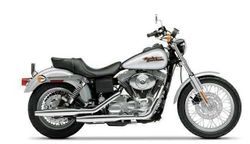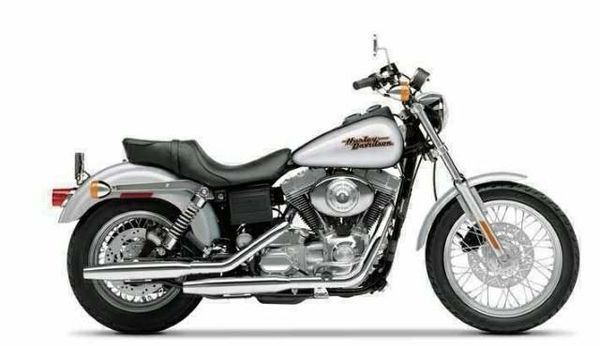Harley-Davidson FXD Dyna Super Glide
 |
|
| Harley-Davidson Dyna Superglide | |
| Manufacturer | |
|---|---|
| Also called | 1340 Dyna Super Glide, Dyna Super Glide T-Sport, FXDXT Dyna Super Glide T-Sport, FXDXI Dyna Super Glide Sport, FXDI35 35th Anniversary Dyna Super Glide, FXDCI Dyna Super Glide Custom, FXDI Dyna Super Glide, FXD Dyna Superglide, Dyna Super Glide Custom, FXDX Dyna Super Glide Sport, FXDC Dyna Super Glide Custom, FXD Dyna Super Glide, Dyna Super Glide Sport, Dyna Super Glide |
| Production | 1991 - 94 |
| Engine | Four stroke, 45° V-Twin, OHV, 2 valves per cylinder. |
| Compression ratio | 8.5:1 |
| Ignition | Analogue CDI |
| Transmission | 5 Speed |
| Frame | Mild steel, tubular frame; rectangular section backbone; stamped, cast and forged junctions, forged fender supports; MIG welded |
| Suspension | Front: 39 mm w/ polished aluminum fork triple clamp and dual-rate springs Rear: Coil over shock |
| Brakes | Front: Single 292mm disc Rear: Single 292mm disc |
| Front Tire | 130/90-16 |
| Rear Tire | 130/90-16 |
| Weight | 271.0 kg / 597.5 lbs (dry), |
| Oil Filter | K&N KN-173[1] |
| Fuel Capacity | 16 Liters / 4.2 US gal |
| Manuals | Service Manual |
Engine[edit | edit source]
The engine was a Air cooled cooled Four stroke, 45° V-Twin, OHV, 2 valves per cylinder.. The engine featured a 8.5:1 compression ratio.
Drive[edit | edit source]
Power was moderated via the Wet 9-plate.
Chassis[edit | edit source]
It came with a 130/90-16 front tire and a 130/90-16 rear tire. Stopping was achieved via Single 292mm disc in the front and a Single 292mm disc in the rear. The front suspension was a 39 mm w/ polished aluminum fork triple clamp and dual-rate springs while the rear was equipped with a Coil over shock. The FXD Dyna Super Glide was fitted with a 16 Liters / 4.2 US gal fuel tank. The bike weighed just 271.0 kg / 597.5 lbs.
Photos[edit | edit source]
Overview[edit | edit source]
Harley Davidson
FXD Dyna Super Glide
OLD-NAIL OR DESIGN classic, you can't argue with the success Harley-Davidson
has achieved using just two basic engines: the rigidly mounted Sportster, in
either 883cc or 1200cc form, and the rubber-mounted 1340cc unit.
Last year the limited edition Sturgis debuted H-D's new Dyna Glide chassis.
Eleven years ago, another Sturgis debuted H-D's new rubber-mounted 1340cc engine
the Evolution. Now both have met in one full production model called the FXDC
Dyna Glide Custom. In true H-D fashion things are getting better...but slowly.
The 1340cc engine is a gem to use. Two whopping great 88.8mm bore pistons, 45
degrees apart, work over a 108mm stroke with a compression ratio of 8.5:1.
Hydraulic tappets keep the two pushrod-operated valves in order, while the
mixture is fed by a 40mm Keihin CV carb slightly recalibrated this year for
better cold starting. Primary drive is by chain, final drive by Kevlar
reinforced belt. The whole plot revs lazily to produce a claimed 621b.ft of
torque at just 3600rpm.
And torque is what matters; revving a Harley 1340 much above 45O0rpm brings
little reward in either propulsion or pleasure. It thrives on short-shifting,
low revving riding. But what of the new, improved chassis? Well, the big leap it
makes over the earlier set-up is that rather than having three rubber engine
mounts, the Dyna Custom has two: one front, one back.
And these are no ordinary mounts. Sandwiched between two steel plates is a
metal block sandwiched by rubber pads. The steel plates bolt to the engine, the
inner block bolts to the frame. The result is far better isolation of the frame
from the engine than the simple ) rubber encased bolt of the other 1340s. The
Dyna Glide chassis also has a slightly longer swing-arm allowing the belt to run
outside the frame; renewal of said belt no longer needs removal of said
swing-arm.
On the road all this progess translates into a smoother, less tiring ride
than found on other Evos. There's still a residual thump-thump-thump at
tick-over, but above 2500rpm the ride is one of seamless,' abundant torque and
very little vibration.
Helping this civilised face for the 90s is the five-speed box which, while
still some way from the best on the market, boasts a light, positive action and
minimal throw. You mustn't rush it, or flywheels get outwitted, but given a
modicum of patience it delivers the goods. It plays only a walk-on part in the
Harley Thang anyway. The best policy is to snick the Dyna Custom into fourth or
fifth (the latter is possibly a little high in fact, with only three grand
needed on the tacho to register 70mph on the speedo) and ride on the generous
curve of power available from 2000rpm upwards.
Using a 1340cc H-D engine is so refreshingly different that it's hard to
compare it with anything else. Suffice to say that lopping along is a real
pleasure. It's relaxing, soothing, sexy. But what of those incidentals Harley
rarely addresses properly? Brakes, suspension, steering?
First, the good news. The twin 292mm discs up front are better than any
standard Harley set-up yet. They're still only single-piston caliaffairs sure,
but new pad and disc materials have paid dividends in both power and feedback.
However, they're a world away from a top-notch Japanese or Italian setup. The
rear is on par with the front, and use of both on a Harley is a necessity.
A glance at the chassis' 65in wheelbase and 32 degree rake angle should give
a fair clue as to the handling characteristics; it's a long, slow-steering beast
which is difficult to correct if off line. The new, grippier, Dunlop Elite tires
introduced last year a 10Q/90-19 up front and 130/90-16 at the rear are
ample for the gentle power and limited lean angles of the Dyna Custom. As you'd
expect, straight-line stability is excellent and it's only in the tighter stuff
that you miss the response of something nimbler.
Suspension, too, is far from the standards set elsewhere. The front 39mm
forks are passable but the old Harley bugbear of underdamping still afflicts
them magnified now by increased braking performance. For the twin
preload-adjustable rear shocks, however, there is no excuse. Working over just
7.6cm of travel they're underdamped and undersp-rung. The bouncy and bumpy ride
is tradition still faithfully adhered to in Milwaukee. In its element the
slow, straight roads of the US of A the FXDC is wanting for little. Put it on
a rougher, sweeping European thoroughfare, ask it to perform at any great speed,
and its shortco
| Make Model | Harley Davidson FXD Dyna Super Glide |
|---|---|
| Year | 1991 - 94 |
| Engine Type | Four stroke, 45° V-Twin, OHV, 2 valves per cylinder. |
| Displacement | 1337 cc / 81.5 cu-in |
| Bore X Stroke | 88.8 x 108 mm |
| Cooling System | Air cooled |
| Compression | 8.5:1 |
| Lubrication | Dry sump |
| Induction | 38mm Keihin carburetor |
| Ignition | Analogue CDI |
| Starting | Electric |
| Max Power | 67 hp / 48.9 kW @ 6000 rpm |
| Max Torque | 97 Nm / 71.5 lb-ft @ 2350 rpm |
| Clutch | Wet 9-plate |
| Transmission | 5 Speed |
| Final Drive | Belt |
| Gear Ratio | 1st 10.110 2nd 6.958 3rd 4.953 4th 3.862 5th 3.150 |
| Frame | Mild steel, tubular frame; rectangular section backbone; stamped, cast and forged junctions, forged fender supports; MIG welded |
| Front Suspension | 39 mm w/ polished aluminum fork triple clamp and dual-rate springs |
| Rear Suspension | Coil over shock |
| Front Brakes | Single 292mm disc |
| Rear Brakes | Single 292mm disc |
| Front Tire | 130/90-16 |
| Rear Tire | 130/90-16 |
| Dry Weight | 271.0 kg / 597.5 lbs |
| Fuel Capacity | 16 Liters / 4.2 US gal |
References[edit | edit source]
- ↑ 2019 K&L Supply Co Catalog. K&L Supply Co. 2019.
